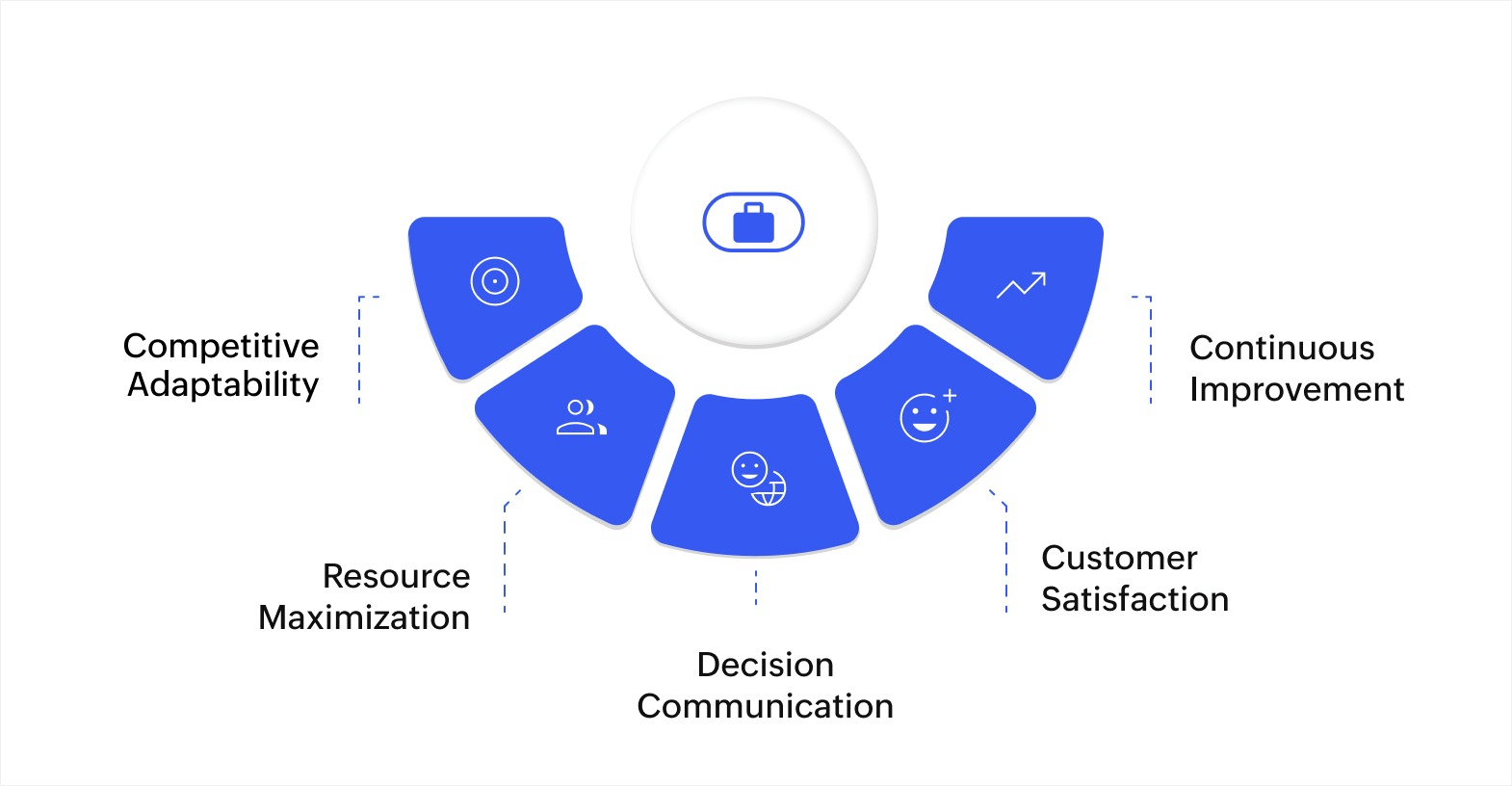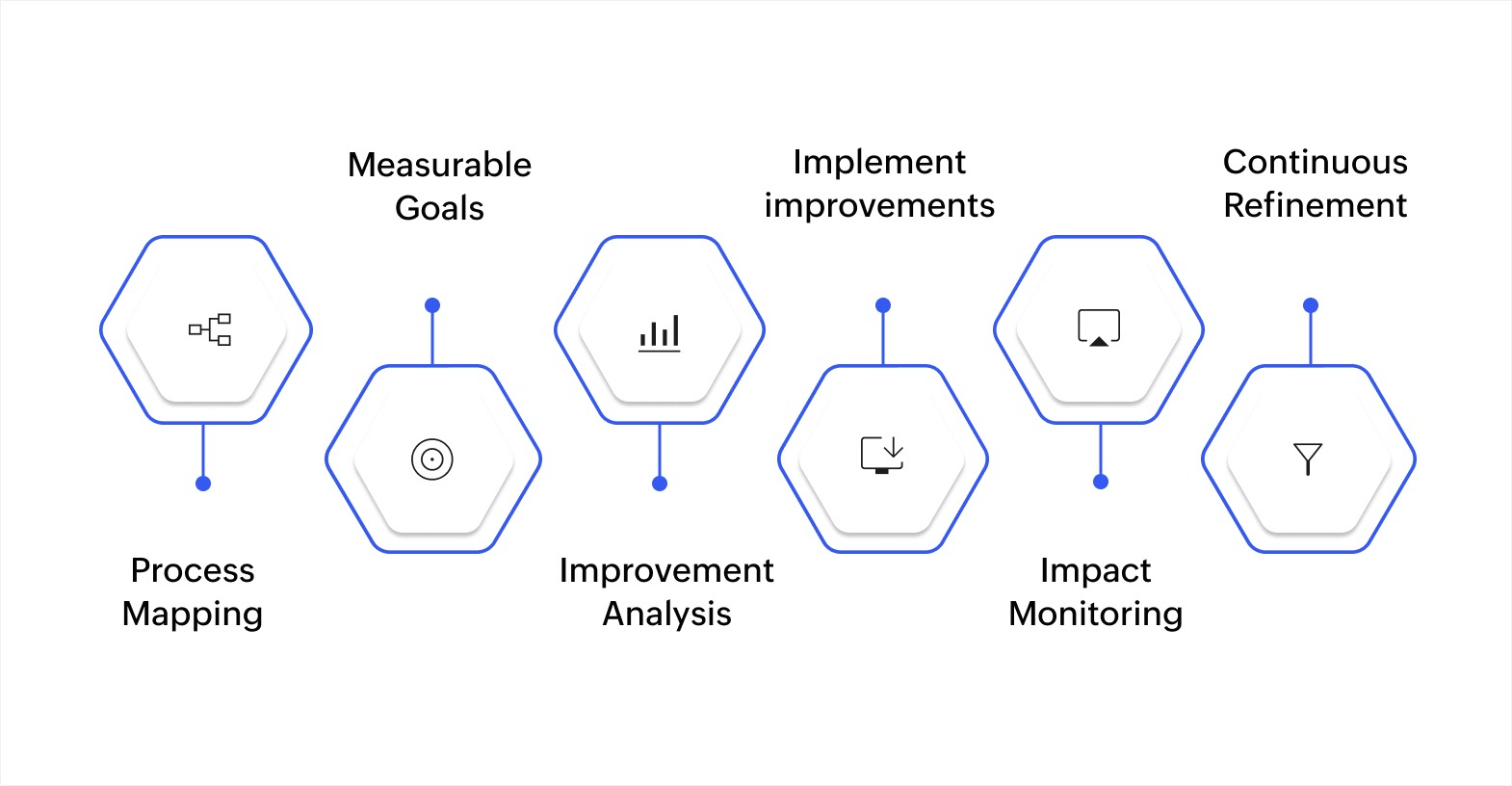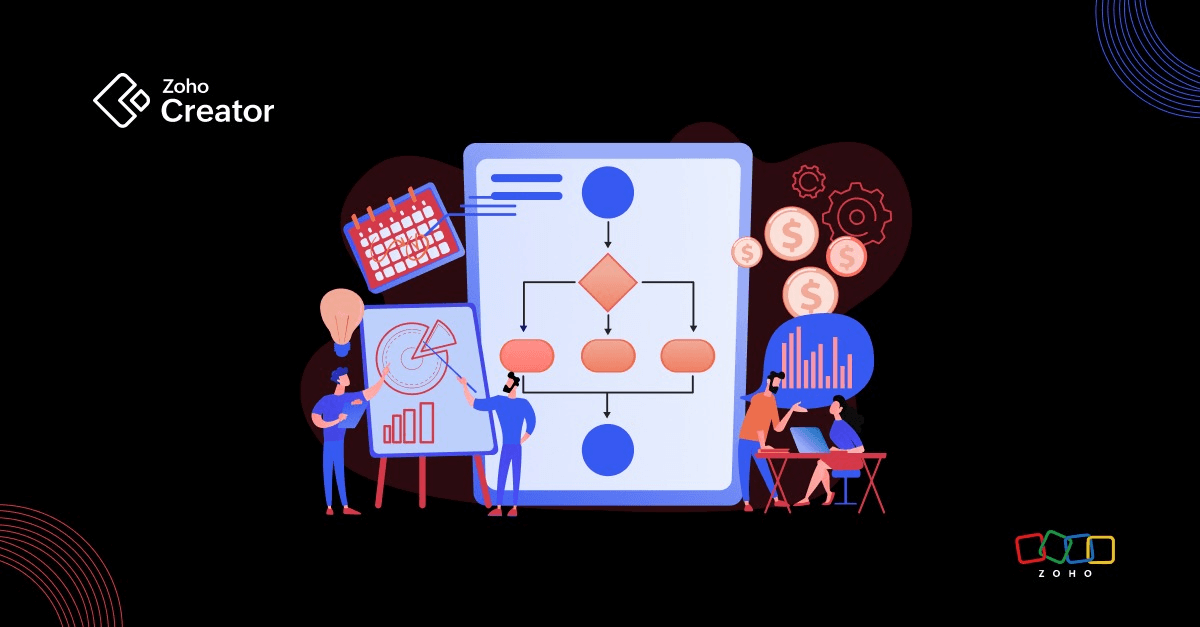- HOME
- Know Your Tech
- Business process optimization: A step-by-step guide
Business process optimization: A step-by-step guide
- Last Updated : October 30, 2025
- 118 Views
- 8 Min Read
What if you could achieve more in your business without adding additional resources? As a business leader, executive, or operations manager, you're constantly facing pressure to improve efficiency and reduce costs, but finding the right approach can often feel like a challenge. That's where business process optimization becomes essential. It's about working smarter with the resources you already have, eliminating inefficiencies, simplifying your workflows, and ensuring your team operates at its highest capacity.
The global business process management market is experiencing significant growth, and is projected to reach USD $61.17 billion by 2030—up from USD $20.38 billion in 2024, with a compound annual growth rate (CAGR) of 20.3%. This clearly shows that businesses who focus on optimizing their processes are the ones who stay ahead.
In this blog, we'll explore how you can optimize your processes, tackle common inefficiencies, and enable your team to work more effectively. Whether you're struggling with time-consuming tasks, inconsistent workflows, or a lack of visibility, we have you covered. Let's see how small changes can lead to significant results.
What is business process optimization?
Business process optimization is the strategic approach to enhancing workflows to boost efficiency and drive performance. It focuses on identifying inefficiencies, automating routine tasks, and aligning processes with organizational goals. The objective is to streamline operations, maximize resource utilization, and deliver consistent, high-quality outcomes.
For instance, optimization could involve automating manual data handling, improving cross-department collaboration, or redesigning workflows to eliminate redundancies. The ultimate aim is to boost productivity, reduce operational costs, and uphold excellence across all areas of the business.
Why is optimization essential for business?

According to recent data, 67% of businesses use automation solutions to enhance end-to-end visibility across various systems, which enables better coordination and more informed decision-making. The benefits of business process optimization are far-reaching and lead to tangible improvements in day-to-day operations and long-term performance. By refining workflows, your business can achieve better efficiency, reduced costs, and enhanced team collaboration.
- Maintain a competitive edge and adapt to change: By eliminating inefficiencies and refining workflows, your business can quickly respond to changing market conditions, evolving customer demands, and shifting regulations and stay ahead of the competition without disruption.
- Maximize resources and increase profitability: Refining workflows helps make the most of available resources by reducing waste and enabling your business to achieve more with less. Simplifying operations also reduces costs and increases output, resulting in improved profit margins.
- Enhance decision-making and communication: Clearer processes and more accurate data enable informed, strategic decisions, while improved communication among teams leads to smoother operations and better outcomes.
- Enhance customer and employee satisfaction: Faster response times, higher-quality products, and more accurate services all contribute to improved customer satisfaction. Additionally, automating repetitive tasks enables employees to focus on more meaningful work, which improves job satisfaction and engagement.
- Foster continuous improvement: Process optimization isn't just a one-time effort; it creates a culture of ongoing innovation and adaptation and enables your business to improve continuously and remain agile as needs evolve.
These benefits highlight how optimizing your processes can enhance resource allocation and overall performance. Implementing these improvements strengthens your business by making it more agile and better equipped to navigate future challenges.
Common challenges in business process optimization
Optimizing business processes can lead to significant improvements, but it isn't without its difficulties. From integrating disparate systems to overcoming employee resistance, these challenges can slow down progress. Addressing these issues early on will help you manage the complexities of optimization and achieve smoother, more effective results.
- Integration complexity: Many businesses rely on multiple systems that don't always work well together. Integrating these systems for seamless process flow can be a challenging task.
- Resistance to change: Employees often resist new ways of working, especially when they're accustomed to existing processes. Overcoming this resistance requires clear communication and proper training.
- Implementation difficulty: In larger organizations, optimizing processes can involve restructuring workflows, adopting new tools, or even changing business structures—all of which require careful planning.
- Upfront costs: While process optimization delivers long-term savings, the initial investment in technology, training, and infrastructure can be significant.
- Data security and compliance risks: Optimizing processes often involves digitization or automation, which can raise concerns about data security and regulatory compliance.
Recognizing these challenges early enables you to address them with a targeted strategy, which in turn ensures a smoother and more impactful optimization journey.
Steps to achieve effective business process optimization
By implementing a structured and methodical approach, companies can identify inefficiencies, decrease operational costs, and drive superior performance. For executives in IT and operations, the objective is to improve processes through automation, system integration, and ongoing refinement to create an efficient workflow that supports both short-term objectives and long-term business growth.

Identify and map current processes
The journey to business process optimization begins with identifying and mapping out current workflows. This foundational step ensures that all business processes are fully understood and accurately documented. Technically, this involves:
- Defining process boundaries: Precisely determine the limits of each workflow to avoid ambiguity.
- Breaking down tasks: Deconstruct each process into smaller tasks and sub-processes for clear visibility.
- Mapping data flows: Visualize the flow of data across different systems, departments, and teams.
- Visual representation: Use process modelling tools (like BPMN or flow diagrams) to document the process flow.
By mapping these processes with precision, you identify areas that are slowing down operations and enable yourself to focus on the most impactful improvements in later steps.
Set clear, measurable goals
Now that you have a comprehensive view of your processes, setting clear goals is essential to direct optimization efforts effectively. From a technical perspective, this step requires:
- Defining actionable KPIs: Choose key metrics like throughput, processing time, and error rates to measure success.
- Benchmarking with data: Use historical data to set realistic targets for performance improvement.
- Goal alignment: Ensure that your process goals are aligned with broader organizational objectives and IT infrastructure capabilities.
These measurable targets guide your optimization strategy, helping you track progress and identify areas where further technical intervention may be needed.
Analyze for improvement opportunities
With processes mapped and goals set, the next step is to perform a technical analysis. The goal here is to identify precise opportunities for optimization. Consider:
- Data-driven insights: Use business intelligence tools to analyze current process performance and pinpoint inefficiencies.
- Process mining: Employ advanced techniques like process mining to track workflow inefficiencies and identify delays.
- Lean Six Sigma: Apply this methodology to identify waste or non-value-added steps within processes.
- Workflow automation suitability: Evaluate which steps are repetitive and could benefit from automation. Platforms like Zoho Creator allow you to design and implement custom automated workflows with minimal coding to ensure routine tasks are handled efficiently while maintaining visibility and control.
This stage is about finding specific weaknesses that you can address with technology, whether it's process redesign, automation, or system integration.
Implement changes for optimization
At this stage, you should take your analysis of current workflows and implement technical solutions for process optimization. This could involve:
- Redesigning workflows: Simplify workflows to remove unnecessary steps, improving both speed and quality.
- Integrating systems: Use API integrations to connect siloed systems to ensure data flows smoothly and reduce the need for manual intervention.
- Deploying automation: Implement automation tools like robotic process automation (RPA), AI-driven task management, or low-code applications to enhance efficiency and accuracy.
- Testing and validation: Run pilot programs to test your new processes and ensure your changes align with the expected performance metrics.
This is where technical tools such as workflow management systems and integration platforms come into play, as they enable you to build a more efficient and automated environment.
Monitor results and measure impact
Once changes are in place, you need to monitor the outcomes closely to ensure your optimization efforts are effective. From a technical perspective, monitoring tools are essential:
- Real-time performance tracking: Use dashboards and monitoring tools to measure real-time performance against your defined KPIs.
- Data analytics: Continuously analyze process data to identify trends, anomalies, or unexpected variations.
- System feedback loops: Establish automated feedback loops that enable systems to self-adjust when performance deviates from set parameters.
The ability to measure the impact of your optimization efforts ensures that you can adjust your strategies swiftly if things aren't progressing as expected.
Continuous refinement and improvement
Optimizing business processes is a continuous cycle, not a one-time fix. For long-term success, implement a system for continuous refinement:
- Feedback incorporation: Regularly gather insights from employees, stakeholders, and systems to inform further process improvements.
- Scalability consideration: As new technologies emerge, continuously evaluate your processes to incorporate innovations like AI, machine learning, or IoT-based automation.
- Agile methodology: Use agile techniques to iterate and implement process changes quickly based on new data or business needs.
By embedding a culture of continuous improvement, you can ensure that your business processes evolve in line with emerging industry trends and technological advancements.
Choosing the right process optimization tools
Choosing the right process improvement tool is essential for enhancing operations and reducing reliance on IT resources. The right software optimizes workflows, increases productivity, and provides actionable insights—all while enabling business executives, product leaders, and startup founders to drive growth and achieve their strategic goals more efficiently.
Key features to look for
When evaluating process optimization tools, consider these essential features:
Customizable application development
Look for a platform that enables you to build applications specifically tailored to your unique business processes. This ensures your workflows and data management align perfectly with your operational needs and provide flexibility for future adjustments.
Visual workflow automation
A user-friendly drag-and-drop interface can significantly streamline the creation of automated workflows and reduce the need for complex coding while ensuring that routine tasks, approvals, and processes are handled efficiently and effectively.
Real-time data management
A reliable tool should provide centralized access to live data. This enables all stakeholders to have up-to-date, accurate information, which supports better decision-making across the organization.
Advanced reporting and analytics
Having customizable reports and dashboards is essential for monitoring the performance of business processes. Look for tools that offer in-depth analytics and allow you to track progress, identify inefficiencies, and make data-driven improvements.
Smooth integrations
Select a solution that seamlessly integrates with other systems and tools to ensure data flows smoothly across platforms. The ability to connect with third-party applications is vital for maintaining a cohesive and efficient ecosystem.
Scalability and flexibility
As your business grows, your processes may become more complex. A good optimization tool should scale with your business needs and adapt to increased demands without sacrificing performance or functionality.
Mobile accessibility
Ensure the platform allows for access on mobile devices. This flexibility enables your team to manage processes and respond to business needs from anywhere—thereby improving overall efficiency and responsiveness.
User access controls
Data security is a priority. A good tool should provide role-based access that allows you to control who sees and edits different information. This feature ensures compliance with security standards and internal policies.
By selecting a solution that incorporates all these features, you ensure your business can simplify its processes, enhance productivity, and foster growth. The right tool should make these capabilities straightforward to integrate.
Platforms like Zoho Creator enable organizations to build applications and automated workflows customized to their operational needs. Instead of providing pre-built BPM software, Creator allows teams to design processes, automate tasks, and maintain visibility and control over business operations.
Create faster, smarter workflows for long-term success
Optimizing business processes is essential for improving efficiency, reducing costs, and enhancing scalability. Manual tasks, outdated systems, and a lack of automation can slow your operations. Following a structured approach can eliminate inefficiencies, improve workflows, and better align operations with your strategic goals.
Simplifying operations doesn't have to involve complex IT projects. With Zoho Creator, your team can build and deploy powerful applications using a user-friendly low-code platform. It's designed to automate daily tasks, reduce reliance on IT teams, and bring transparency to business processes—so you can move faster and make smarter decisions.
From tracking requests to managing assets or automating approvals, Zoho Creator helps you turn clunky workflows into efficient, connected systems.
 Ann Elizabeth Sam
Ann Elizabeth SamHey! I'm Ann, and I work as a content writer at Zoho Creator. I'm exploring the SaaS world through various forms of content creation. Outside of work, I love dancing and would give up anything to read a good murder mystery.



